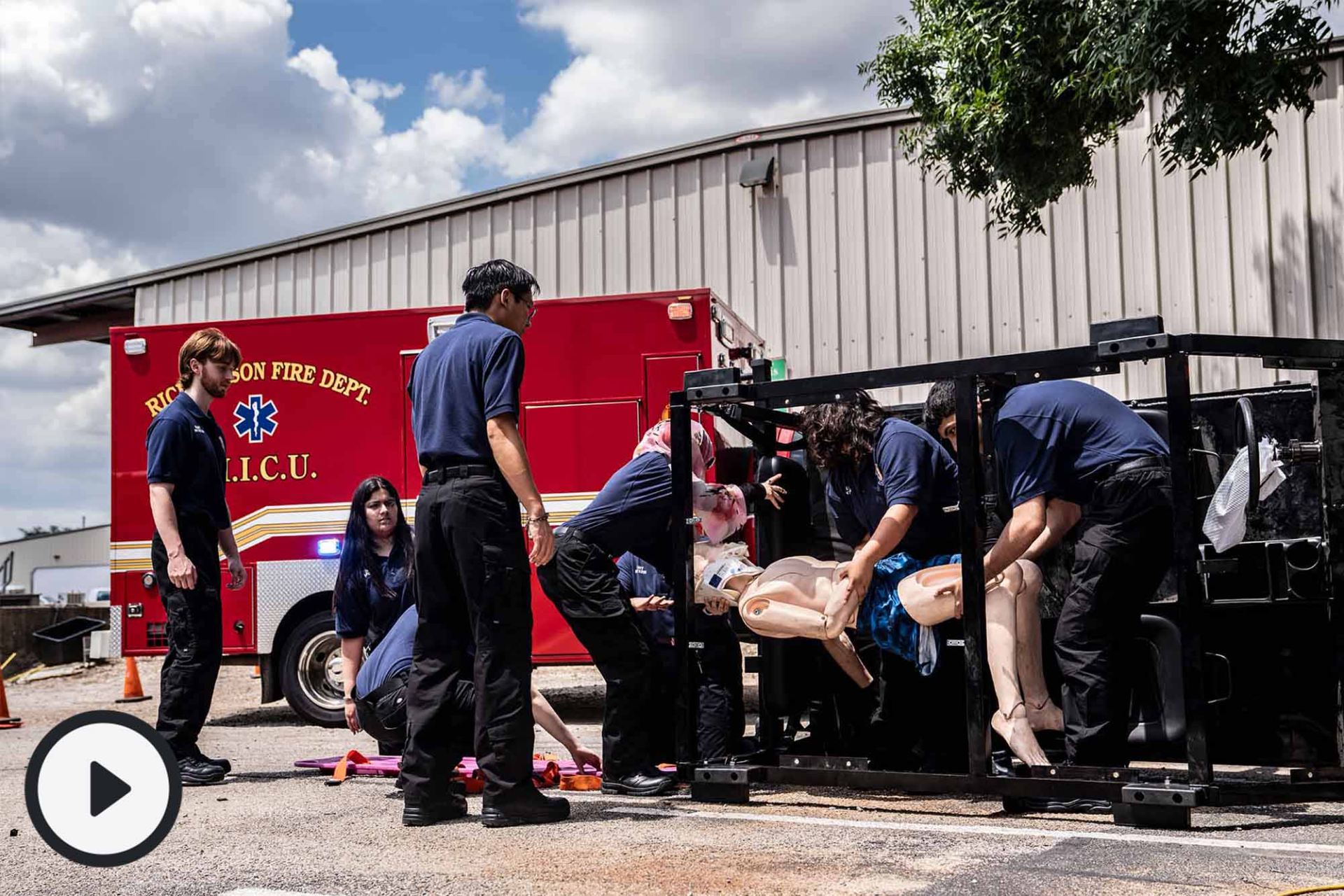UTDesign Team Adds Helping Hand to Campus Emergency Response Training


The mannequin dangled from the front seat of an overturned simulated vehicle in an exercise for students training to become emergency medical technicians at The University of Texas at Dallas.
The students in the University Emergency Medical Response (UEMR) program carefully removed the seat belt and placed a neck brace on the mannequin to prevent spinal cord injuries before transferring it to a stretcher.
The simulated vehicle has made UEMR’s training far more realistic this summer thanks to the work of six mechanical engineering students, now alumni, who built the tool during the 2024-25 academic year as part of the UTDesign Capstone program in the Erik Jonsson School of Engineering and Computer Science.
UEMR, a first-responder organization at UT Dallas, began using the simulator in June.
“The vehicle simulator is a great resource to show the students how to get patients out of vehicles,” said Sheila Elliott, EMS director and advisor of the UEMR program. “Being able to use the simulator makes our training more functional and flexible and pertains a lot more to real-life scenarios.”
The simulator, which looks like the metal frame of a four-seat vehicle, can be turned upside down or on its side to offer a realistic experience. Before they had the new tool, students had to practice removing the mannequins from Elliott’s personal vehicle.
Elliott initially considered buying a patient extrication simulator, but the commercially available systems were expensive and did not include some of the features she wanted. So, she sponsored a UTDesign team that then partnered with Collin College’s welding program, which provided essential fabrication expertise, to develop the tool.
Jacob Meyer BS’25, the UTDesign team lead, said he and his teammates were excited to work on the project.
“I’m really glad we built something that is actually going to be used day in and day out and that is going to help students in their careers,” Meyer said. “It worked out well for everybody.”
Meyer’s teammates were Ibrahim Salem BS’25; Daniel Camero BS’25; Ben Brock BS’25; Roman Berry BS’25, now a mechanical engineering graduate student; and Martin Delgado BS’25.
In addition to providing learning experiences for the UTDesign team and UEMR, the Collin College welding students had an opportunity to work on a large-scale aluminum project.


Cesar Lopez BS’20, a welding professor at Collin College who served as a mentor to the UTDesign team, said he and his students fit and welded the parts of the frame together.
“It was a great learning experience; the students were really interested in the project,” said Lopez, whose UTD degree is in mechanical engineering.
The Collin College team’s assistance significantly reduced the cost of the project, too, Meyer said. The UTDesign team was able to build the system for $7,500, about half the price of a commercially available version.
The UTDesign team custom-built the simulator to have four seats and a variety of steering wheel options, including one with an inflated airbag. The design also features windshield stickers that replicate broken glass patterns, which often indicate different types of injuries.
The UTD students chose aluminum to create a lighter-weight simulator and included a seat belt that does not need to be cut and replaced with each use; instead, there are buckles that slide apart to imitate cutting a seat belt. The simulator can be flipped by hand with two users utilizing handles to ensure safety.
Elliott, who worked with the UTDesign team throughout the academic year, said she was impressed with the engineering students’ skills.
“Every meeting felt like I was working with a professional engineering firm,” Elliott said. “They were motivated; they were eager; they were very passionate about the project to see it come to fruition.”
Dr. Robert Hart, professor of practice in mechanical engineering and UTDesign mechanical engineering faculty director, said the project demonstrates the impact that a single UTDesign project can have on the university and the community.
“The team did a fantastic job, and I am excited to see that what they created is already being used to benefit UEMR program students,” Hart said. “It was also great to be able to partner with the program at Collin College.”
In addition to offering EMT and paramedic courses, UEMR has almost 100 certified EMTs and paramedic volunteers who respond to medical emergencies on campus.
Media Contact: Kim Horner, UT Dallas, 972-883-4463, kim.horner@utdallas.edu, or the Office of Media Relations, UT Dallas, (972) 883-2155, newscenter@utdallas.edu.





